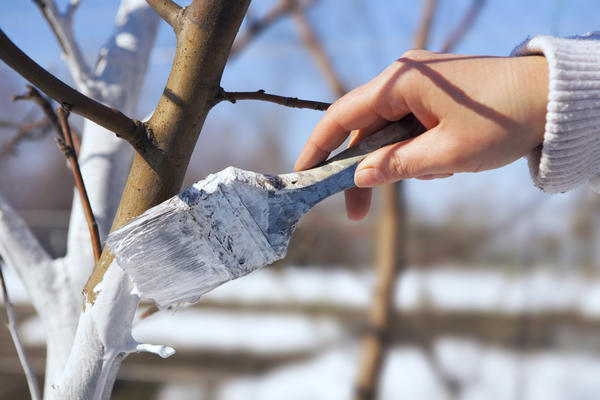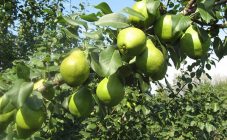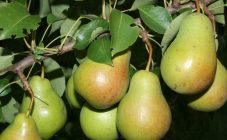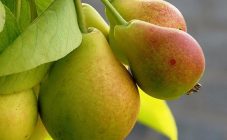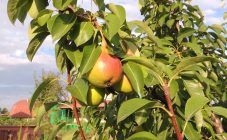Content:
Various varieties of pears are used fresh or they are used for making desserts, side dishes, juices, salads. The fruits of pear hybrids are used in medicine to treat diabetics, eliminate heart rhythm disturbances, and prevent other diseases.
Variety history
Pear Nadyadnaya Efimova was obtained by crossing the varieties Tonkovotka and Lyubimaya Klappa. The work was carried out at the Moscow Biological Station in 1935-36. The group of scientists was headed by V. Efimov.
Research continued after the war. As a result of the further development of the hybrid, the Holiday pear was introduced in 1960. Unlike the parent variety, this species begins to bear fruit as early as 3 years after planting, has an increased yield - up to 60 kg per tree, but its frost resistance is reduced. This hybrid was included in the lists of the State Register in 1974.
Description of pears Elegant Efimova
The height of the tree reaches 4-5.5 m. Its crown is of a pyramidal type. The branches extend from the trunk at sharp angles. They have an average number of leaves that look like large ovals. Shoots are painted in dark red tones. The bark of the variety is smooth, gray in color. The kidneys are elongated and smooth.
Fruit characteristics:
- the average fruit weight ranges from 90-120 g, but some gardeners managed to get specimens weighing up to 180 g;
- subcutaneous inclusions are visible under the smooth skin;
- the removal of fruits from the tree is done when they are painted in green and yellow shades;
- a fully ripe pear has a burgundy color;
- large seeds;
- the pulp is juicy and tender, white in the context;
- the taste is sweet, with a little acid.
This pear hybrid has a yield of up to 40 kg per tree. Fruiting begins at 6-8 years after planting the seedlings.
With a sunny summer, the harvest is carried out in the last days of August, and with cloudy weather, it is postponed until September. In the description of Efimova's elegant pear in the agricultural catalog, it is indicated that the variety has good frost resistance. In winter, an adult tree does not need to be wrapped, but it is recommended to insulate young seedlings with a special material (reeds) and protect them from small rodents.
This pear hybrid develops well in poor soils, which allows it to be grown almost everywhere. The main pollinator for this variety is a bee, but it is advisable to place pear hybrids of a different type next to it for cross fertilization.
How to grow a tree
The plant thrives on spacious areas that are illuminated by the sun. If grown in shaded corners of the garden, the fruits become smaller, their sweetness decreases.
Although the elegant Efimova can grow on poor soil, it is better to place it on black earth, loamy or sandy soil. If its acidity exceeds 6 pH, the soil is fertilized with lime and wood ash.
For planting, young trees are purchased that are 1-2 years old.Their height should exceed 60 cm in the presence of formed skeletal branches. The bark on the cuttings should not have any rotten areas or chips.
Pear hybrids are planted in autumn or early spring. To do this, dig a hole 0.75-0.8 m deep and up to 1 m in diameter. Manure or humus (up to 30 kg), superphosphate and potassium sulfide (0.1 kg each) are laid inside. In the center of the hole, a stake is strengthened, which serves as a support for the seedling. Then a tree is installed and covered with earth. A circular ditch is made around the trunk, 3 buckets of warm water are poured into it.
In the description of the pear, Elegant Efimova, it is indicated that in order to increase its yield, the following pollinators must be planted next to it:
- Marble,
- Bessemyanka,
- Yakovlev's favorite.
It is desirable to have 2-3 types of hybrids on the site. Planting maintenance is needed throughout the growing season.
Fruit trees are irrigated every 6-7 days. To do this, early in the morning, under each young pear, from 20 to 30 liters of ox is poured. If the weather is hot or drought, the intensity of moisture is increased by 3 times. If there are fruit-bearing trees in the garden, they are watered 2 times a season (during bud break and at the end of flowering), 50-60 liters of water are poured under each plant.
Fertilizers are given to pear seedlings in spring. Top dressing is carried out with ammonium nitrate. The next time the procedure is carried out in the fall, but potash mixtures are already given to the trees at the rate of 20 g of substance per 10 liters of water. When forming buds, it is advisable to treat the hybrids with superphosphate, and after flowering - with nitrophosphate. When ovaries appear, wood ash is introduced into the soil.
This variety needs magnesium. Fertilizing with a microelement is carried out at the beginning of summer. For this, a solution of metal sulfate in water is used (0.2 kg of chemical per bucket of liquid).
Weeding of the near-trunk circle from weeds is carried out once a month. The soil under the pears is mulched with a layer of peat and sawdust. Its thickness must be at least 100 mm.
Pruning of pear hybrids is done in spring. Remove all old, dry or diseased branches, shorten young shoots by 1/3.
For the prevention of diseases, the pear is processed as follows:
- sprayed with urea solution in early spring;
- whitewash the trunks with lime 2 times a year;
- remove fallen leaves, dry and diseased branches.
Such measures are recommended only if diseased trees are found in the garden.
If the hybrids are attacked by garden pests, the parasites are destroyed with drugs that kill both the insects themselves and their eggs, and caterpillars. Although the Nadyadnaya variety suffers little from them, it is recommended to constantly inspect the plants and take protective measures in time.
An adult tree tolerates winter cold well, therefore it does not need special protective equipment. After planting, the seedlings should be wrapped in warm materials (2-3 years), and with a sharp drop in air temperature, it is advisable to fumigate their trunks with smoke.
Advantages and disadvantages of a hybrid
Pear Efimova has the following advantages:
- the ability to withstand severe frosts allows you to grow the variety in cold climates;
- beautiful appearance and taste of the fruits are not lost during storage;
- the plant retains a high yield without the use of insulation products even after a harsh winter;
- the variety is immune to many fungal diseases;
- this pear hybrid belongs to a group of trees that are unpretentious in care.
Description of pear Nadyadnaya Efimova points out the disadvantages of the variety:
- fruits must be removed from the branches before they are ripe, otherwise they will deteriorate and fall off;
- the plant has low early maturity.
Any farmer can grow the described hybrid at his own site without high costs. For this, it is necessary to carry out agrotechnical measures for the care of the tree in a timely manner.

